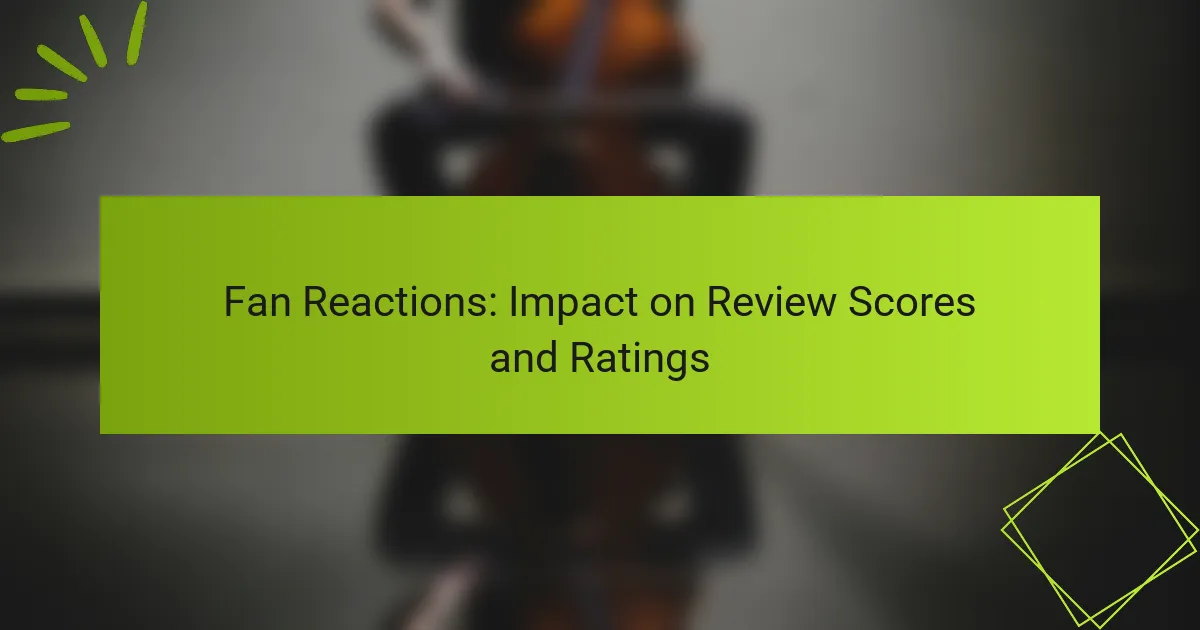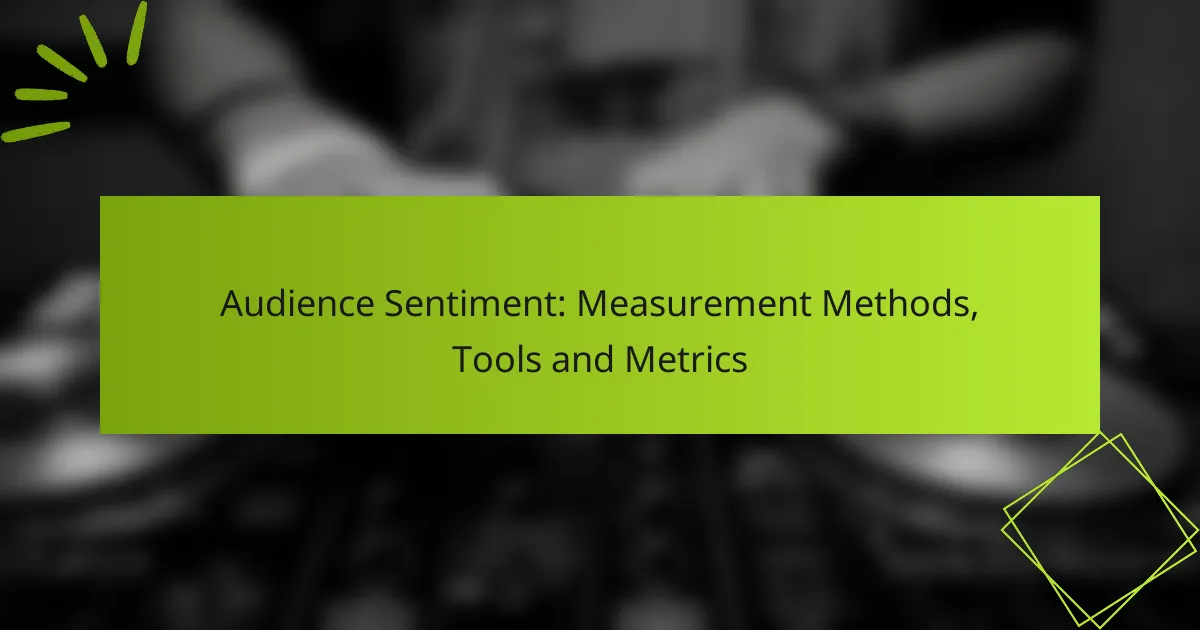Live performances create a distinctive atmosphere that deepens emotional connections and leaves lasting impressions on audiences. The energy and immediacy of these events not only enhance engagement but also significantly influence how attendees perceive the performance, ultimately shaping their reactions and reviews.

How do live performances impact audience reception?
Live performances significantly enhance audience reception by creating a unique atmosphere that fosters emotional connections and lasting memories. The immediacy and energy of a live event can transform how attendees perceive and engage with the performance, leading to varied reactions and reviews.
Emotional engagement
Live performances evoke strong emotional responses from audiences, often more intense than those experienced through recorded media. The shared experience of being in the same space as the performers allows for a deeper connection, as emotions can be amplified by the energy of the crowd and the performers’ presence.
For example, a live concert can elicit feelings of joy, nostalgia, or even catharsis, depending on the music and the atmosphere. This emotional engagement often translates into more favorable reviews and personal recommendations, as attendees feel a personal stake in the experience.
Memorable experiences
Attending a live performance creates memorable experiences that can last a lifetime. The combination of sights, sounds, and the ambiance of the venue contributes to a unique event that cannot be replicated. Audiences often remember specific moments, such as a powerful song or an unexpected interaction with the artist.
These memorable experiences can lead to positive word-of-mouth and social media sharing, further influencing public perception and reviews. For instance, a surprise guest appearance or an encore performance can become defining moments that enhance the overall reception of the event.
Social interaction
Live performances facilitate social interaction among attendees, which can enhance the overall experience. Sharing the event with friends or meeting new people creates a sense of community that enriches the performance. This interaction can lead to discussions about the performance, fostering a shared understanding and appreciation.
Moreover, social media plays a significant role in amplifying these interactions. Attendees often share their experiences online, posting photos and comments that can influence others’ perceptions and encourage attendance at future events. Engaging with fellow audience members can also lead to a more favorable reception of the performance itself, as collective enjoyment often enhances individual experiences.
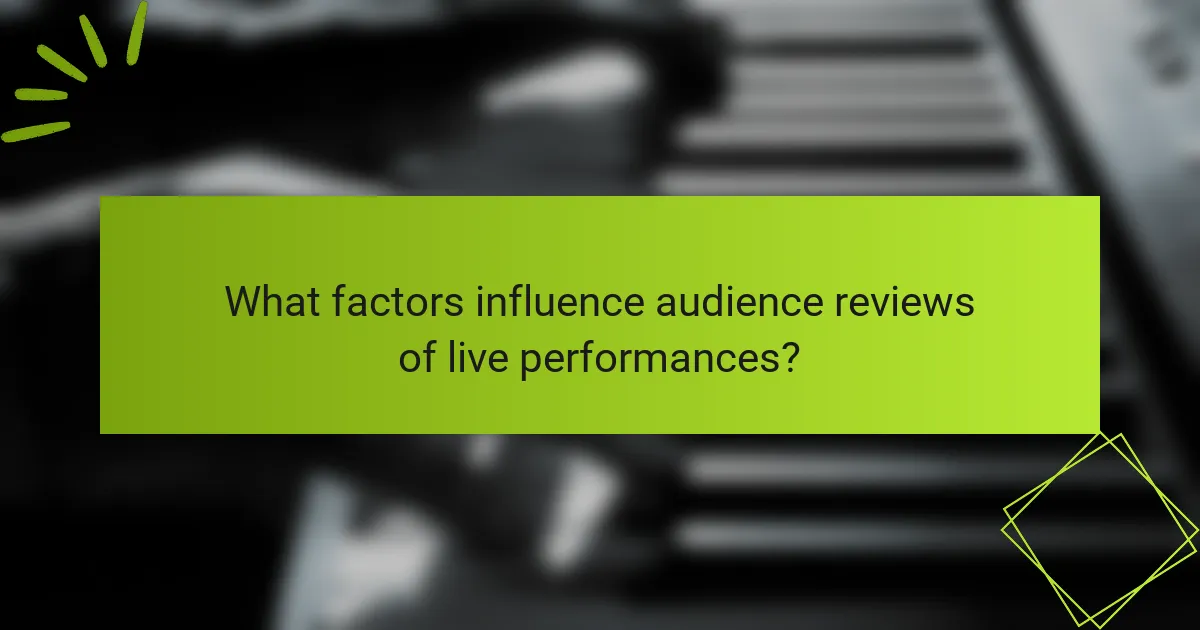
What factors influence audience reviews of live performances?
Audience reviews of live performances are primarily influenced by the quality of the performance, the atmosphere of the venue, and the level of interaction between the artist and the audience. Each of these factors plays a significant role in shaping the overall experience and satisfaction of attendees.
Performance quality
The quality of a live performance is often the most critical factor in audience reviews. This includes the technical skill of the performers, the execution of the material, and the overall production value. Audiences tend to favor performances that are polished and engaging, leading to higher ratings and positive feedback.
For example, a concert with well-rehearsed musicians and high-quality sound engineering is likely to receive better reviews than one with technical issues or lackluster performances. Audiences generally appreciate when artists deliver their best work, which can significantly influence their perception and subsequent reviews.
Venue atmosphere
The atmosphere of the venue can greatly enhance or detract from the live performance experience. Factors such as seating comfort, acoustics, lighting, and even the decor contribute to how the audience perceives the show. A welcoming and vibrant environment can elevate the performance, making it more memorable.
For instance, an intimate theater with excellent acoustics may create a more engaging experience than a large arena with poor sound quality. Venues that foster a sense of connection between the audience and performers often receive more favorable reviews.
Artist interaction
Interaction between the artist and the audience can significantly impact reviews of live performances. Engaging with the crowd through storytelling, humor, or direct communication can create a sense of connection that enhances the overall experience. Audiences often appreciate when artists acknowledge them, making the performance feel more personal.
For example, a performer who takes time to interact with fans, respond to cheers, or invite audience participation typically receives positive feedback. Conversely, a lack of interaction can lead to a more detached experience, resulting in less favorable reviews.

How do different genres affect audience perception?
Different music genres significantly influence how audiences perceive live performances. Each genre carries its own cultural context, emotional resonance, and expectations, which shape audience reactions and reviews.
Rock concerts
Rock concerts often evoke a high-energy atmosphere, encouraging audience participation through singing and dancing. Fans typically expect a dynamic performance with powerful sound and engaging visuals, which can lead to enthusiastic reviews if these elements are met.
Factors such as the band’s charisma, setlist, and venue acoustics play crucial roles in shaping audience perception. For instance, a well-known band performing at a large stadium may create an electrifying experience, while a smaller venue might foster a more intimate connection.
Classical performances
Classical performances are generally characterized by a more formal atmosphere, where audience members are expected to maintain decorum. The perception of these events often hinges on the technical skill of the musicians and the interpretation of the pieces being performed.
Audiences tend to appreciate the nuances of orchestration and the emotional depth of the music. Reviews often focus on the conductor’s ability to convey the piece’s intent and the musicians’ precision, with standout performances receiving high praise for their artistry.
Hip-hop shows
Hip-hop shows are known for their vibrant energy and strong connection between the artist and the audience. Fans expect not only musical performance but also engaging storytelling and social commentary, which can greatly influence their reception of the event.
Key elements such as stage presence, lyrical delivery, and crowd interaction are critical. A hip-hop artist who effectively engages the audience through call-and-response techniques or personal anecdotes can leave a lasting impression, leading to positive reviews and heightened fan loyalty.

What role does technology play in live performances?
Technology significantly enhances live performances by improving audience experience and expanding reach. It enables artists to connect with fans in real-time and provides tools for interactive engagement, ultimately influencing audience reception and reviews.
Live streaming
Live streaming allows performances to reach a global audience, breaking geographical barriers. Artists can broadcast their shows in real-time, enabling fans who cannot attend in person to participate virtually.
Consider platforms like YouTube Live or Twitch, which facilitate high-quality streaming. However, ensure a stable internet connection and consider potential latency issues that could affect viewer experience.
Audience engagement apps
Audience engagement apps enhance the live performance experience by allowing fans to interact directly with the show. These apps can include features like live polls, Q&A sessions, and feedback options that encourage participation.
Examples include platforms like Slido or Poll Everywhere. When using these tools, ensure they are user-friendly and promote them ahead of the event to maximize participation and engagement.
Social media integration
Integrating social media into live performances can amplify audience interaction and create a buzz around the event. Artists can encourage fans to share their experiences online, using specific hashtags to create a sense of community.
Utilize platforms like Instagram or Twitter for real-time updates and behind-the-scenes content. However, be mindful of managing negative feedback and ensure that the online conversation aligns with the event’s branding and message.
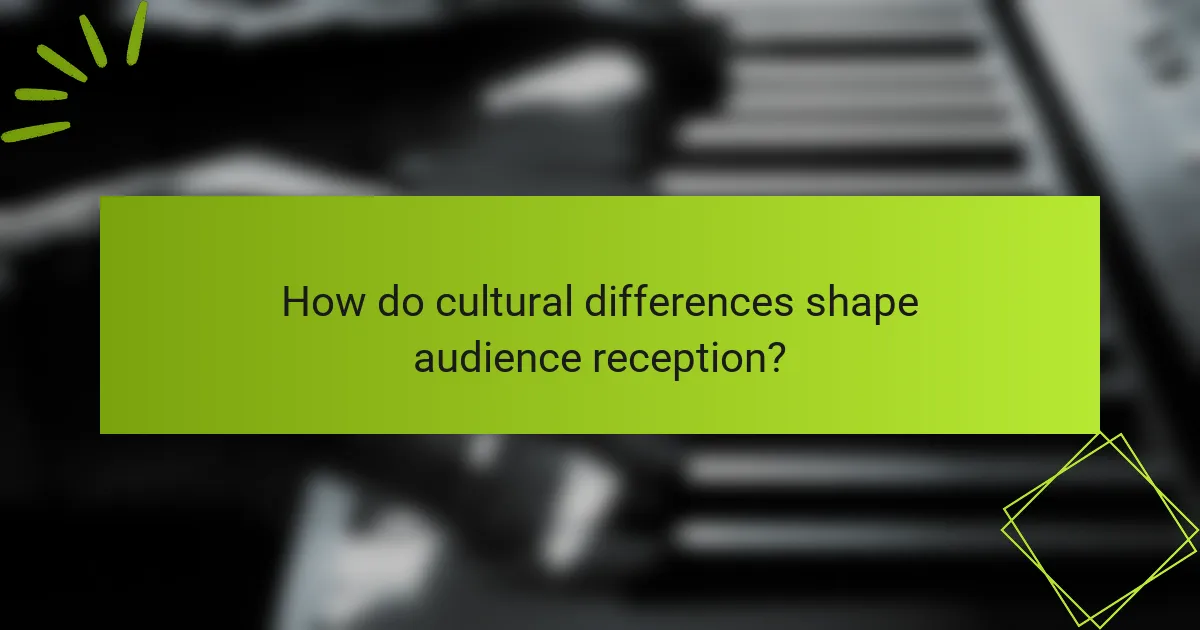
How do cultural differences shape audience reception?
Cultural differences significantly influence how audiences perceive and respond to live performances. Factors such as regional preferences, local customs, and language barriers can greatly affect audience engagement and the overall reception of a show.
Regional preferences
Regional preferences play a crucial role in shaping audience reception. For instance, audiences in North America may favor high-energy performances with elaborate staging, while European audiences might appreciate more subtlety and artistic expression. Understanding these preferences can help performers tailor their shows to resonate better with local audiences.
Additionally, musical genres often have regional roots, impacting the types of performances that draw larger crowds. For example, country music thrives in the southern United States, while electronic dance music is more popular in urban centers across Europe.
Local customs
Local customs can significantly affect how performances are received. In some cultures, audience participation is encouraged, while in others, it may be considered disruptive. For example, in Japan, audiences typically remain quiet and respectful during performances, whereas in Latin American countries, lively interaction and applause are common.
Performers should be mindful of these customs to avoid alienating their audience. Adapting to local expectations can enhance the overall experience and foster a deeper connection with the audience.
Language barriers
Language barriers can impact audience understanding and enjoyment of a performance. When performances include dialogue or lyrics in a language unfamiliar to the audience, it may hinder their ability to fully engage with the content. For example, a theatrical play in English may not resonate with a non-English speaking audience without proper translation or subtitles.
To mitigate this issue, performers can incorporate visual storytelling elements or provide translations for key dialogues. This approach can help bridge the gap and ensure that the essence of the performance is communicated effectively, regardless of language differences.
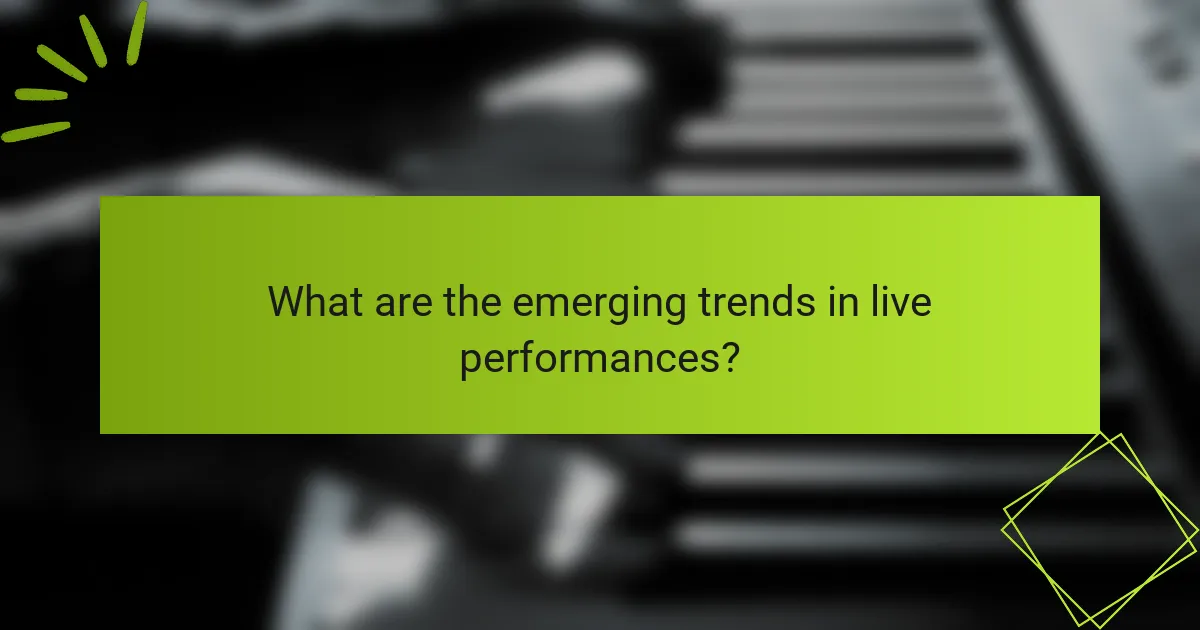
What are the emerging trends in live performances?
Emerging trends in live performances include the integration of technology, a focus on immersive experiences, and a growing emphasis on sustainability. These trends shape how audiences engage with performances and influence their overall reception and reviews.
Integration of Technology
Technology is increasingly becoming a core component of live performances. From augmented reality (AR) to virtual reality (VR), artists are using these tools to create more engaging and interactive experiences for audiences. For example, concerts may incorporate AR visuals that enhance the performance, making it more memorable.
Additionally, live streaming has gained popularity, allowing performers to reach wider audiences beyond physical venues. This trend not only broadens the audience base but also influences how performances are reviewed, as online viewers may share their experiences in real-time.
Focus on Immersive Experiences
Immersive experiences are becoming a priority for many live performances, aiming to fully engage the audience’s senses. This can involve unique staging, audience participation, and thematic environments that transport attendees into the performance’s world. For instance, immersive theater often blurs the lines between performers and spectators, creating a more personal connection.
Such experiences can significantly impact audience reception, as they often lead to stronger emotional responses and more enthusiastic reviews. Performers who prioritize immersion may find that their shows are more memorable and generate buzz on social media platforms.
Emphasis on Sustainability
Sustainability is increasingly influencing live performances, with many artists and venues adopting eco-friendly practices. This includes using sustainable materials for staging, reducing waste, and promoting carbon offset initiatives. Audiences are becoming more aware of these efforts, often favoring performances that align with their values.
Incorporating sustainability can enhance a performance’s reputation, leading to positive reviews and increased ticket sales. Artists who communicate their commitment to environmental responsibility may attract a dedicated following, as fans appreciate the effort to minimize ecological impact.

